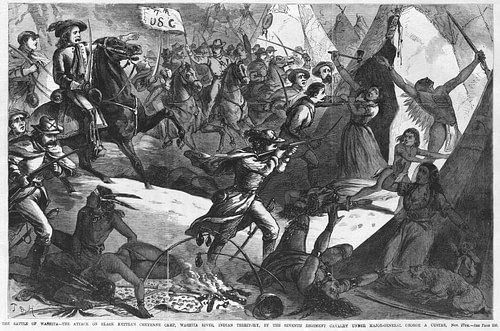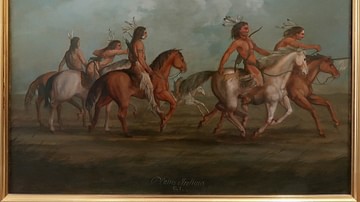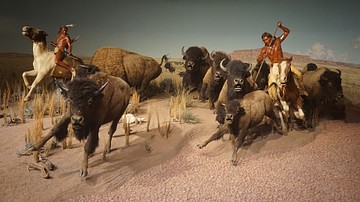The Prophecy of Bear Man is a war story from the Cheyenne nation relating their response to a Pawnee horse-raiding party and how they defeated their enemy, regaining most of the horses taken. The story exemplifies Native American warfare in which conflicts, especially in the 19th century, often revolved around hunting grounds and horses.

Horses came to represent communal and personal wealth, and so the more horses an individual or community had, the greater their prestige and power. Stealing horses from another tribal community was common in that this not only took away the source of their pride but also shamed them while enriching those who now claimed the horses as their own. Raiding parties usually struck at night or early in the morning before dawn, but those organized to retaliate and regain the horses were sent out as quickly as the theft was detected, as in this story.
The horse, introduced to North America by the Spanish in the 16th century, revolutionized the lives of the Plains Indians, as noted by scholar Larry J. Zimmerman:
The Plains horse, a short, stocky, shaggy descendant of the mixed Andalusian and Arabian breeds introduced by the Spanish, was a liberating force in the agricultural villages and hunters' camps of the Plains. The new animal brought a fantastic increase in power and mobility, quickly becoming indispensable to hunter and warrior alike. The Spanish had first introduced horses to the Southwest, but it was on the vast, open Plains where the animal had the greatest impact on the lives of the people that acquired them. Tribes that had hunted buffalo communally on foot shifted to fast-paced outings conducted by individuals on horseback, which enabled a good hunter to kill a number of animals quickly. Among many Indian tribes, horses became a measure of wealth and status.
(138)
The loss of an individual's or community's horses to theft, therefore, was a serious matter requiring an immediate response. If one failed to protect one's horses from raiding parties, one had no choice but to go after the thieves, not only to bring back what had been lost but also to punish the guilty with a death sentence. The details of these kinds of conflicts were then told and retold as war stories at communal events, elevating the status of warriors who had conducted themselves courageously or had 'counted coup' on an enemy (touching the opponent or striking without killing) or performed admirably in some other capacity. In time, these stories became part of the literature not only of the Cheyenne or Plains Indians but of Native peoples of North America generally.
Visions & Signs
The central theme of The Prophecy of Bear Man, as the title suggests, is not a conflict over horses but the very real danger one invited by ignoring a vision. Bear Man is confident in the vision he sees, and, when he relates the warning of the Pawnee raid to others, they accept it as an accurate prophecy; when it does not come true according to their expectations, however, they let down their guard, forget the message sent by the Creator God Maheo (the Wise One Above), and allow for the Pawnee to steal the horses. If they had remained vigilant, they would not have had to go after the raiding party and would not have lost two of their fastest steeds.
This is a common theme in Native American literature – trust in the messages, signs, and signals from the higher realm – regardless of how circumstances may seem at a given time. In the Cheyenne tale, The Life and Death of Sweet Medicine, for example, the prophet Sweet Medicine, who had been driven from his community earlier, returns and demands they prepare a tipi and gather there to hear the vision he has been given for them. In this case, the people listen and obey and so receive the Four Sacred Arrows, instruction on how to live in accordance with Maheo's will and, further, they are rewarded for their compliance with Sweet Medicine's demands in that the famine they had been suffering is lifted with the return of the buffalo.
The story also features one of the most famous Cheyenne chiefs, Black Kettle (l. c. 1803-1868), depicted here as a young man but still wise and skillful enough to lead the band that goes after the Pawnee to take back the stolen horses. Black Kettle is best known as the 'peace chief' who repeatedly tried to find a way to live in harmony with the Euro-Americans who had arrived in his land but ultimately failed as every treaty he signed was intentionally broken or ignored by the representatives of the US government. His village was attacked on 29 November 1864 in what became known as the Sand Creek Massacre and again on 27 November 1868 in the Washita Massacre/Battle of Washita River where he was killed. Long before this, though, he led his people well whether in peace or during times of conflict like the one described in the following story.

Text
The following version comes from By Cheyenne Campfires (1926) by George Bird Grinnell, republished by University of Nebraska Press in 1971.
In the winter of 1856-1857, a part of the Cheyenne were camped for the winter on Running Creek. Three bands of them were there, the Wuh'ta piu, O i' vi manah', and Hev a-taniu. One day, a medicine man called Bear Man, after coming out of a sweat house where many old men were taking a sweat, stopped by some men who were sitting smoking near the pile of earth where the buffalo skull faces the sweat house, and said to them, "While my friends there were all singing inside the sweat house, I saw something."
"What is it," said the others. "Tell us about it."
"As we were sitting there," said Bear Man, "praying and sweating, it came into my mind strongly that it will be good for us to keep close and tie up all our gentle horses, for in my mind I saw coming toward our camp on foot a war party of Pawnee. The leader was carrying in his arms something wrapped up in a cloth."
When Bear Man had finished speaking, Bear Tongue rose to his feet and went through the camp, crying out and telling all the people what Bear Man had seen in his vision.
As the sun drew to the west, all the people drove up their horses and all the gentle ones were tied up. Some young men went out a little way from the camp and watched during the night for the Pawnee. Two nights passed and nothing happened. On the third day, people began to say that Bear Man must have been mistaken in his vision, and that night they did not tie up their horses, and on this third night everything was quiet. Nobody thought anything of Bear Man's vision.
Early in the morning after the fourth night, a young man came running into the camp, calling out that the Pawnee had stolen horses. He held in his hand a Pawnee arrow that had dropped out of a Pawnee quiver while its owner was getting on a horse. The man's tracks showed where he had mounted a Cheyenne horse. All the men now ran out to see if their horses were taken. When the women went down to the stream for water, they found a blanket that a Pawnee had lost. Those who were out hunting for their horses came to a place on the hill below the camp where the Pawnee had sat in a row and made prayers before taking the horses. On the ground, they had marked horse tracks leading toward the Pawnee country. They had left their sacks just as they had set them in a row, with corn and dried meat in the sacks, and also some moccasins. They had driven the horses by this place and taken a few of their things, for their tracks showed where they had dismounted.
Thus it was seen that Bear Man's vision had come true. His prophecy was fulfilled. The Cheyenne came back to the camp and told what they had seen and now men began to saddle up their horses to follow the trail. As the men were beginning to start, Bear Tongue cried out, "Follow them slowly, for the Pawnee have not taken very many good horses." The best horses were above the camp but the Pawnee, coming up the stream, had taken the horses below the camp and mainly from the camp of the Hev'a-taniu. The clans Wuh ta piu and O i vi Manah' were camped further up the creek and their horses were above the camp.
Black Kettle had been chosen as the leader on this trip. He was a young chief and had married into the Wuh ta piu group. When they stopped that evening, he said to the young men: "Now we are getting close to the Pawnee. All those of you who have good horses must saddle them and leave your poor horses here. Those of you who are riding slow horses stay here with these horses."
A good many of the men were riding common horses and leading their war horses, but some people whose good horses had been stolen were riding poor horses. Buffalo were all about them, and Black Kettle told those who were going to stay there not to go away from the place, but to go out and kill some fat cows, so that when his party returned, they might have plenty to eat. He told them also to keep up a good fire during the night, for he and his party would come back as soon as they had overtaken the Pawnee.
Black Kettle and his party started on the trail and, when they got near the Solomon River, Black Kettle told his men to form in line and all to get off their horses. Then Black Kettle took an arrow from his quiver and stepped ahead of his men and held the arrow as if he were going to shoot; then he drew the arrow back and came to his men and said to them: "Do you see the point of that hill over there? Right under it the Pawnee are resting and eating."
All mounted their horses and charged for this point and, when they reached it, they found that the Pawnee had just left it. The fire was still burning. They had killed a buffalo and had been roasting meat. The Cheyenne then started down the creek and had not gone very far when they saw the Pawnee rounding up the horses and trying to catch the fast horses to get away on. But the Cheyenne were all on good horses and they were too quick for the Pawnee. Two Pawnee caught fast horses, one a white horse that belonged to Thin Face and one a gray horse that belonged to Lump Nose. These two were noted horses. Thin Face and Lump Nose, who in their younger days had been great warriors, had stayed back with those that had the slow horses, as leaders of that party.
Five Pawnee ran to the timber nearby and got among the willows and cottonwood trees, but the Cheyenne got all around them, and it did not take them long to kill all five. The two on fast horses got away. The Cheyenne knew that they could not catch them, so they let them go. Antelope was the first man to count a coup.
They had recovered all their horses except the two that the Pawnee had ridden off and nine more that were still missing. These nine were eight unbroken mares and a very old mule that had been broken to ride.
It was night when they turned back. On the way, they stopped to rest and, early next day, started on, though their horses were getting very tired. Black Kettle said, "Let us stop on the creek and dress the scalps," and they did so and rested for a time. They all said, "We must not show the scalps to the other party until we get near them and then we can shake the scalps in their faces." This was the custom in those days.
The party that had been left behind got up on the hill to watch those who were approaching to see whether anyone had been hurt or killed, but those who were coming made no signal. When Black Kettle and the others got close to those who had stayed behind, and were just about to shake the Pawnee scalps at them, Thin Face, who was Black Kettle's brother-in-law, ran up to Black Kettle and pulled out a scalp from under his robe and waved it in front of Black Kettle's face. Black Kettle and his party were surprised at this. Thin Face pointed down the creek and said to them, "You will find his carcass there." He meant that they had killed the Pawnee there.
When those that were left behind went out to kill buffalo, they saw a man driving eight head of horses and riding a mule. This Pawnee was unlucky. The horses he had taken were all unbroken mares. Only the old mule was gentle and could be ridden. In the darkness, these wild mares looked fat to the Pawnee, and he thought he was getting a fine herd, but in the morning he found his mistake, for he had nothing to ride but this very old mule.
The Cheyenne say that this man must have been crazy. When they charged toward him, he jumped off the mule and ran down the creek. He came to a coyote hole and spread his buffalo robe over the hole and pulled his Moccasins off and placed them on the ground in such a way that it looked as if he were lying down there. At first the Cheyenne thought he was lying in the hole and, when they charged him, the first man struck the robe with his bow and then saw that there was no Pawnee there. They ran further down the creek, searching everywhere, and at length found him hiding in the bed of the stream.
When he saw that he was discovered, he jumped up, holding his bow and a handful of arrows. He pointed to the sun and made signs that he was like the sun and that it would be a great thing for them if they should kill him that day. The Cheyenne say that, whether he was crazy or not, he made a good fight. Twice he came very near catching Thin Face and they say that, if he had been on a horse, he would have killed a number of them. Thin face fought on foot and the Pawnee kept running after him. Big Nose had a gun and got off his horse to shoot at him, and when the Pawnee saw that Big Nose was off his horse, he made a dash for him. Big Nose got behind his horse to shoot but the Pawnee did not turn back but kept rushing toward him and, when he got very close, Big Nose shot him, and he fell. For a long time, the Cheyenne were afraid to go close to him. Once before he had lain on the ground and pretended that he was shot and, when they went near to him, he had jumped up and run after them. They thought he was playing this trick again.
After loading his gun, Big Nose walked up to the Pawnee, and he was dead. They say he was a fine-looking young man.
This time, the Cheyenne got six scalps and got back all their horses except two that the Pawnee had ridden off. For the rest of the winter, the Cheyenne held big scalp dances.





